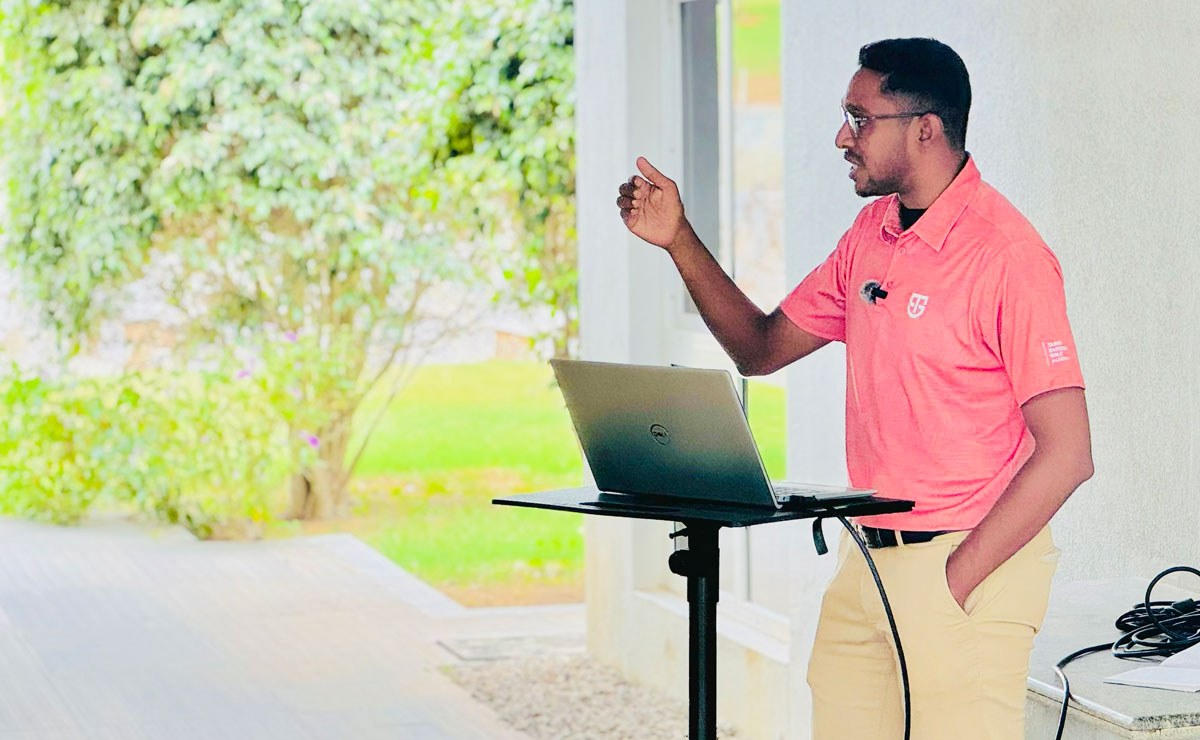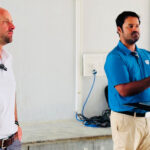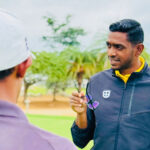At Tarun Sardesai Golf Academy (TSG), there has always been much more to the game than just shot-making and playing mechanics. When it is golf, it demands both- mental toughness and physical skill. If uncertainty, distractions, or anxiety cloud the mind, even a technically sound swing may fail under pressure.
Understanding this, TSG places a strong emphasis on Sports Psychologisting players on the importance of mental flexibility, or the ability to control their thoughts and feelings while competing without allowing them to impact their performance.
Now the question, “Is your head in the game, or is the game in your head?” was the core question of a recent player’s meet conducted by Sports Psychologist Pranav. So, let’s get into it and see what are the key learnings for our golfing audience!
Is the game in your head or your head in the game?
All skill levels of golfers are aware of the struggle between concentration and distraction. Sports Psychologist Pranav started by asking the players to consider what frequently diverts their focus during a round. Some key pointers included:
- The scorecard and performance pressure.
- A poor beginning that sticks in your head.
- Previous errors on well-known vulnerabilities.
- Fear of looking foolish in front of your peers.
- The persistent sense that one is not “good enough.”
From amateurs to pros, all golfers go through them. However, how a player responds to these thoughts frequently determines whether they perform well under pressure or not.
The Balancing act of a Golf Ball
Sports Psychologist Pranav conducted a straightforward exercise to emphasize this notion. At first, it was simple for players to balance a golf ball in their hands. However, players became aware of the amount of mental work needed to maintain control as the activity became more difficult (balancing on one leg, then with eyes closed).
The play in the competition was reflected in this simple exercise. The game feels easy on the range, where there is no pressure. However, during competition, the mind is balancing expectations, self-doubt, and nerves and at the end, it’s like attempting to balance several forces at once.
The lesson learned?
You will never feel at ease under pressure. As a golfer, your objective must revolve around performance despite the discomfort, rather than focusing on eliminating it.
To think is to think.
One of the most essential concepts Sports Psychologist Pranav emphasized was that thoughts are simply thoughts, with no inherent “positive” or “negative” aspects. Labeling them as good or evil makes them more effective on the golf course.
An example of this would be a player standing on a tee box and thinking of imaginative consequences. That thinking by itself doesn’t result in the shot; instead, the player’s obsession with avoiding it redirects attention from execution.
By acknowledging thoughts as some imaginative stories rather than real dangers, golfers can prevent them from taking over their game. Players are better able to identify and let go of intrusive thoughts by giving them names, such as “Dr. Pepper moments,” as one psychologist notably proposed. This helps players focus on the shot at hand.
Using Mindfulness as a Golfing Tool
Being aware, or remaining grounded in the present moment, is essential for mental flexibility. An Olympic-inspired practice called “engaging the senses to ground awareness” was introduced by Sports Psychologist Pranav.
In this activity, players worked in pairs to identify what they could taste, smell, see, hear, feel, or think. They were able to acknowledge their feelings and ideas without resistance or condemnation due to this technique.
The lesson behind this activity was to showcase that feelings and ideas don’t have to be suppressed or repressed; they can be acknowledged and explored. All they have to do is be recognized and then put aside as the player makes their shot.
The Rory vs. Cam Smith Contrast
To illustrate mental flexibility, Sports Psychologist Pranav drew examples from professional golf. He compared Rory McIlroy and Cam Smith during high-pressure moments.
Rory’s Approach: Trying to suppress nerves, forcing himself to feel calm.
Cam’s Approach: Accepting nerves as natural, yet focusing entirely on execution.
The difference?
Rory’s attention stayed focused, not feeling nervous, which created rigidity. Cam, though equally nervous, flowed through the moment by embracing discomfort and executing anyway. Golfers don’t need to “fake” calmness. They need to recognize discomfort and still trust their ability to perform.
Developing Mental Flexibility: An essential part of TSG Training
Here are some notable and effective ways that can help you develop your mental strength.
- Acknowledge discomfort: The practice range will always feel easier than playing golf under pressure. As a golfer, you must accept the turbulence of competition instead of aiming for perfect shots.
- Give up battling thoughts: Negative thoughts may follow you, but you have the freedom to ignore them. Consider them anecdotes rather than orders and that’s how you will be able to perform better.
- Use your senses as an anchor: To remain in the moment, practice mindfulness exercises such as identifying emotions, deep breathing, or sensory awareness.
- Emphasis on Positive, Clear Instructions: Give yourself clear instructions ( for example- “swing through to the target”) rather than instructing yourself not to do anything (for instance- “don’t hit OB”).
Develop your mental flexibility as a skill.
Mental flexibility needs to be developed in a range and used in competition, just like your swing. Sports Psychologist Pranav emphasized to the players that mental flexibility is a muscle that takes time to develop. It requires constant training, just like any other skill or physical strength. Because of TSG’s emphasis on holistic development, players are trained to enhance create both mental and physical toughness, enabling them to compete at their highest level under any circumstances.
Every golfer must contend with distractions, pressure, and uncertainty. Those who embrace them, refocus their focus, and give their all to the shot at hand are the champions, not those who dodge them.
Taking Part in the Game, not the Story
A common description of golf is that it’s a game played between the ears. Winning this internal battle is just as crucial to TSG as any technical improvement. Players were advised during Sports Psychologist Pranav’s session that the goal is to embrace their thoughts and nerves and maintain concentration on the game, rather than letting their minds wander into the wild.
Golfers can develop the ability to maintain mental flexibility, balance, and resilience through constant practice- both on and off the course thereby transforming obstacles into opportunities and pressure into a positive experience. That is the core of TSG’s player-first strategy: developing golfers who are not only exceptional athletes but also psychologically prepared to succeed in every situation.
So, keep navigating yourself through every aspect of the game and don’t forget to have fun.
Happy golfing!



